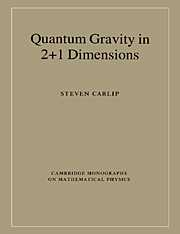Book contents
- Frontmatter
- Contents
- Preface
- 1 Why (2+1)-dimensional gravity?
- 2 Classical general relativity in 2+1 dimensions
- 3 A field guide to the (2+1)-dimensional spacetimes
- 4 Geometric structures and Chern–Simons theory
- 5 Canonical quantization in reduced phase space
- 6 The connection representation
- 7 Operator algebras and loops
- 8 The Wheeler–DeWitt equation
- 9 Lorentzian path integrals
- 10 Euclidean path integrals and quantum cosmology
- 11 Lattice methods
- 12 The (2+1)-dimensional black hole
- 13 Next steps
- Appendix A The topology of manifolds
- Appendix B Lorentzian metrics and causal structure
- Appendix C Differential geometry and fiber bundles
- References
- Index
2 - Classical general relativity in 2+1 dimensions
Published online by Cambridge University Press: 15 December 2009
- Frontmatter
- Contents
- Preface
- 1 Why (2+1)-dimensional gravity?
- 2 Classical general relativity in 2+1 dimensions
- 3 A field guide to the (2+1)-dimensional spacetimes
- 4 Geometric structures and Chern–Simons theory
- 5 Canonical quantization in reduced phase space
- 6 The connection representation
- 7 Operator algebras and loops
- 8 The Wheeler–DeWitt equation
- 9 Lorentzian path integrals
- 10 Euclidean path integrals and quantum cosmology
- 11 Lattice methods
- 12 The (2+1)-dimensional black hole
- 13 Next steps
- Appendix A The topology of manifolds
- Appendix B Lorentzian metrics and causal structure
- Appendix C Differential geometry and fiber bundles
- References
- Index
Summary
If we wish to quantize (2+1)-dimensional general relativity, it is important to first understand the classical solutions of the Einstein field equations. Indeed, many of the best-understood approaches to quantization start with particular representations of the space of solutions. The next three chapters of this book will therefore focus on classical aspects of (2+1)-dimensional gravity. Our goal is not to study the detailed characteristics of particular solutions, but rather to develop an understanding of the generic properties of the space of solutions.
In this chapter, I will introduce two fundamental approaches to classical general relativity in 2+1 dimensions. The first of these, based on the Arnowitt–Deser–Misner (ADM) decomposition of the metric, is familiar from (3+1)-dimensional gravity; the main new feature is that for certain topologies, we will be able to find the general solution of the constraints. The second approach, which starts from the first-order form of the field equations, is also similar to a (3+1)-dimensional formalism, but the first-order field equations become substantially simpler in 2+1 dimensions.
In both cases, the goal is to set up the field equations in a manner that permits a complete characterization of the classical solutions. The next chapters will describe the resulting spaces of solutions in more detail. I will also derive the algebra of constraints in each formalism – a vital ingredient for quantization – and I will discuss the (2+1)-dimensional analogs of total mass and angular momentum.
- Type
- Chapter
- Information
- Quantum Gravity in 2+1 Dimensions , pp. 9 - 37Publisher: Cambridge University PressPrint publication year: 1998

